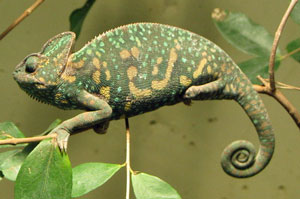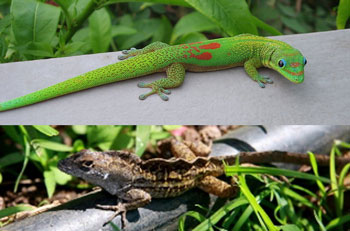|
Identification:
Jackson's chameleons are a popular pet that can escape the cage and establish feral populations in Hawaii. They are bright emerald green fading to a yellowish color on their undersides. Males are generally 10-12 inches long with a long, prehensile tail accounting for half of their length and with three horns protruding from their forehead. Females are generally a little shorter and never grow horns. Jackson's chameleons are solitary creatures which spend most of their time in trees. Chameleons move with a distinctive slow rocking motion.
Impacts: Chameleons ability to thrive in a variety of forest environments where they are yet another predator of Hawaii's native insects, spiders, and snails, making them a less welcome guest in Hawaii. Chameleons are also a potential prey base for the brown tree snake and other snakes, which increases the likelihood of this alien species establishing populations if ever introduced.
Dispersal Mechanism: Chameleons are primarily moved around in Hawaii by humans. It is illegal to transport these animals between islands or to commercially export to the mainland. Penalties can include a fine of up to $200,000 and a possible prison sentence. The Hawaii Department of Agriculture has an amnesty program allowing a person to turn in an illegal animal without prosecution. Chameleons can also be seen crossing roads at night and during rainy days while dispersing to new areas.
Distribution: Introduced from Kenya and Tanzania to Hawaii in 1972, this popular pet was intentionally released in Kaneohe and now has established free ranging populations on the islands of Hawaii, Maui, and Oahu. They have not become established on Kauai- report any sightings!
More information about this pest 
|

|
|
Veiled chameleon, another popular pet and Hawaii Early Detection Network target.
|
|
Other reptiles:
Hawaii has no native terrestrial reptiles, but there are over 30 introduced reptiles that have established wild populations. It is illegal to transport these animals between islands and penalties can include a fine of up to $200,000 and a possible prison sentence. The Hawaii Department of Agriculture has an amnesty program allowing a person to turn in an illegal animal without prosecution.
|

|
|
Two widespread introduced reptiles: (Top) Gold day dust gecko; (bottom) Brown anole
|
|
|